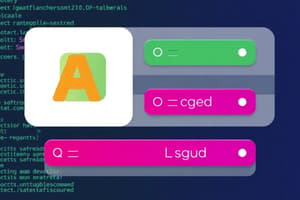Podcast
Questions and Answers
Which of the following is the most accurate description of debugging?
Which of the following is the most accurate description of debugging?
- The process of writing code that is free of errors from the start.
- The process of optimizing code for faster execution.
- The process of identifying and rectifying errors in a program that leads to unexpected behavior. (correct)
- The process of documenting code for better understanding.
A programmer is tracing the code's execution to find the specific lines causing an issue. Which debugging process is being applied?
A programmer is tracing the code's execution to find the specific lines causing an issue. Which debugging process is being applied?
- Fixing the error
- Identifying the cause (correct)
- Understanding the problem
- Examining the error symptoms
Before making changes to the code, a developer attempts to fully grasp the problem, reproduces the issue, and gathers information. Which debugging technique is being used??
Before making changes to the code, a developer attempts to fully grasp the problem, reproduces the issue, and gathers information. Which debugging technique is being used??
- Binary Search
- Backtracking
- Understanding the problem (correct)
- Rubber Ducking
A developer is working backward from where a problem first appeared to understand how and why it happened. Identify the debugging technique in use?
A developer is working backward from where a problem first appeared to understand how and why it happened. Identify the debugging technique in use?
Which debugging tool is designed to halt program execution temporarily at a specific point to allow inspection of the program's state?
Which debugging tool is designed to halt program execution temporarily at a specific point to allow inspection of the program's state?
A programmer faced with a complex problem divides the code into halves to locate a bug by systematically narrowing down the location. Which technique is being used?
A programmer faced with a complex problem divides the code into halves to locate a bug by systematically narrowing down the location. Which technique is being used?
A developer explains a problem out loud to a rubber duck to identify the issue. This is an example of which debugging technique?
A developer explains a problem out loud to a rubber duck to identify the issue. This is an example of which debugging technique?
What is the primary purpose of placing log analysis statements in strategic areas of code?
What is the primary purpose of placing log analysis statements in strategic areas of code?
Grouping error reports into classes of related bugs is known as what?
Grouping error reports into classes of related bugs is known as what?
A developer steps away from the code to clear their mind and allow new ideas to surface. Which debugging practice is this?
A developer steps away from the code to clear their mind and allow new ideas to surface. Which debugging practice is this?
Documenting the debugging process and solutions used is an example of what?
Documenting the debugging process and solutions used is an example of what?
Which of the following describes what an exception is in programming?
Which of the following describes what an exception is in programming?
Which of the provided options is an example of a potential exception in programming?
Which of the provided options is an example of a potential exception in programming?
What is the term for object-oriented techniques that manage or resolve errors?
What is the term for object-oriented techniques that manage or resolve errors?
During program execution, an unplanned exception occurs. What type of error is this classified as?
During program execution, an unplanned exception occurs. What type of error is this classified as?
An error is discovered during program compilation. What type of error is this?
An error is discovered during program compilation. What type of error is this?
Which class represents more serious errors from which a program usually cannot recover?
Which class represents more serious errors from which a program usually cannot recover?
When a program uses an invalid array subscript value, which type of error is most likely to occur?
When a program uses an invalid array subscript value, which type of error is most likely to occur?
The Error and Exception classes descend from which class?
The Error and Exception classes descend from which class?
Which exception is thrown when there is insufficient space to allocate an object?
Which exception is thrown when there is insufficient space to allocate an object?
Flashcards
Debugging
Debugging
The process of identifying and rectifying errors in a program that leads to unexpected behavior.
Examining error symptoms
Examining error symptoms
Successfully identify the symptoms of the issue, such as crashes, error messages, or unexpected behaviors.
Identifying the cause
Identifying the cause
Tracing the code's execution to discovering which specific lines are creating the issue.
Fixing the error
Fixing the error
Signup and view all the flashcards
Understanding the problem
Understanding the problem
Signup and view all the flashcards
Backtracking
Backtracking
Signup and view all the flashcards
Debugging tools
Debugging tools
Signup and view all the flashcards
Breakpoints
Breakpoints
Signup and view all the flashcards
Stepping
Stepping
Signup and view all the flashcards
Binary Search
Binary Search
Signup and view all the flashcards
Rubber Ducking
Rubber Ducking
Signup and view all the flashcards
Log analysis
Log analysis
Signup and view all the flashcards
Clustering Bugs
Clustering Bugs
Signup and view all the flashcards
Exception
Exception
Signup and view all the flashcards
Exception handling
Exception handling
Signup and view all the flashcards
Runtime error
Runtime error
Signup and view all the flashcards
Syntax error
Syntax error
Signup and view all the flashcards
Error Class
Error Class
Signup and view all the flashcards
Exception Class
Exception Class
Signup and view all the flashcards
Finally block
Finally block
Signup and view all the flashcards
Study Notes
- Debugging identifies and fixes program errors causing unexpected behavior.
- It's a critical, time-intensive, and challenging part of programming.
Debugging Process
- Examine error symptoms like crashes and unexpected behavior.
- Identify the root cause by tracing code execution to find the problematic lines.
- Fix the error by making necessary corrections to ensure the code works correctly.
Debugging Techniques
- Fully understand the problem before changing code; reproduce the issue if you can.
- Backtracking, also called backward debugging, starts from the point of the error and works backward.
- Debugging tools offer insights into code function, including variable and memory use; examples are Chrome DevTools, Testsigma, and dbForger.
- Set breakpoints to halt execution at suspected problem areas and inspect the program's state.
- Use stepping to move through code line by line, examining variables and data structures.
- Binary search isolates issues by dividing code into halves to narrow down the bug location.
- Rubber ducking helps by explaining the problem to someone (or something) to force critical thinking.
- Log Analysis involves placing log statements in code to understand execution flow and variable values at different points.
- Clustering bugs group error reports by common cause or pattern to resolve multiple bugs at once.
- Take breaks to clear the mind and get a fresh perspective on the problem.
- Document the debugging process and solutions for future reference.
Exception Handling
- An exception is an unexpected error condition during programming.
- Potential exceptions include file not found, disk full, invalid data type, division by zero, and array index out of bounds.
- Exceptions aren't always "bad" but represent unusual occurrences, like a profit exceeding the maximum integer value.
- Exception handling manages or resolves these errors using object-oriented techniques.
- Runtime errors are unplanned exceptions during program execution.
- Syntax errors are exceptions found during program compilation.
- Error Class: Represents severe errors (e.g., insufficient memory) that the program cannot recover from.
- Exception Class: Represents less serious errors (e.g., invalid array subscript) that the program can recover from.
- In Java, both Error and Exception classes inherit from the Throwable class, which originates from the Object class.
Specific Errors and Exceptions
- IOException: Base class for exceptions thrown when accessing files, directories, and streams.
- RuntimeException: Detected during the application's execution.
- ArithmeticException: Raised when a math operation error occurs during runtime.
- IndexOutOfBoundsException: Thrown when using an invalid index for arrays, lists, or strings.
- ArrayIndexOutOfBoundsException: Signals an attempt to access an array with an illegal index.
- NoSuchElementException: Indicates that the requested element does not exist.
- InputMismatchException: Occurs when the user enters the wrong input type.
- VirtualMachineError: The Java Virtual Machine is broken or lacks necessary resources.
- OutOfMemoryError: Not enough space to allocate an object.
- InternalError: An unexpected internal error in the Java Virtual Machine.
Try, Catch, and Finally Blocks
- "try" procedures that might cause errors.
- A method detecting an error "throws an exception".
- A block of code processing the error is said to "catch the exception".
- try block: Encloses code that might cause an error.
- catch block: Handles exceptions thrown by the try block.
- throw statement: Sends an Exception object to be handled elsewhere.
- The general format of a method including try...catch:
try { // Code that might generate an exception } catch(Exception e) { // Actions to take if an exception occurs }
- A catch block resembles a method named catch() that takes an Exception argument.
- If the try block encounters an exception, the catch block executes; otherwise, it's bypassed.
- finally block: Executes code at the end of a try...catch sequence, regardless of exceptions.
- Used for cleanup tasks that must always happen, such as closing files.
- When a finally block is included, its statements execute before the method is abandoned.
- In a pseudocode example for reading a file, the finally block closes the file, ensuring it's closed no matter the outcome of the try block.
Studying That Suits You
Use AI to generate personalized quizzes and flashcards to suit your learning preferences.




